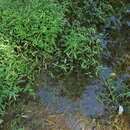Associations
provided by BioImages, the virtual fieldguide, UK
Foodplant / gall
embedded sorus of Bauhinus cordae causes gall of live, swollen, deformed ovary of Persicaria laxiflora
Foodplant / pathogen
sorus of Sphacelotheca hydropiperis infects and damages live ovary of Persicaria laxiflora
Remarks: season: 8-9
Description
provided by eFloras
Erect to suberect, 35-60 cm tall, branched, annual herb. Stem branched from base or above, glabrous. Leaves 2-8.0 x 0.3-2.0 cm, shortly petioled, linear lanceolate, acute, margin, veins and midrib ciliate, sparsely reddish glandular below. Ochreae 1.0-1.5 cm long, tubular, ciliate, ± appressed hirsute, cilia at the mouth of the tube almost equalling the ochreae. Inflorescence, 1-5 cm long, slender, terminal to axillary, often drooping raceme. Flowers 1.5-2.5 mm across, pedicel 0.5-1 mm long. Ochreolae 1.0-2.0 mm long, tubular, reddish-purplish, ciliate-aristate, ciliae or aristae 1-2 mm long. Tepals 5, 1.25-2.5 x 0.5-1.5 cm, oblanceolate, obtuse, biseriate, unequal, pink. Stamens 8, filaments long, inserted below middle, equal. Ovary small, lanceolate, trigonous, with three styles, free in the upper half, stigmas capitate. Nuts biconvex to appressed, 1.5-3.0 x 0.5-1.5 mm, dark brown to almost black, glabrous, lustrous.
- license
- cc-by-nc-sa-3.0
- copyright
- Missouri Botanical Garden, 4344 Shaw Boulevard, St. Louis, MO, 63110 USA
Distribution
provided by eFloras
Africa, Europe, W. Asia, Himalaya, Tibet, east to China and Japan, N. America.
- license
- cc-by-nc-sa-3.0
- copyright
- Missouri Botanical Garden, 4344 Shaw Boulevard, St. Louis, MO, 63110 USA
Distribution
provided by eFloras
Distribution: Himalayas, Europe, N. W. Africa, temperate Asia and North America.
- license
- cc-by-nc-sa-3.0
- copyright
- Missouri Botanical Garden, 4344 Shaw Boulevard, St. Louis, MO, 63110 USA
Habitat
provided by eFloras
A fairly common species, grows between 2500-10000 ft in moist areas, along water channels. Very close to Persicaria hydropiper but differs by having eglandular perianth and often drooping spikes which are often terminal and cilia as long as the ochreal tube. Differs from P. tenella by having distinctly biconvex to appressed nuts and reddish glands on the leaves. Our plants differ from European and N.W.African specimens by having smaller flowers and smaller nuts and may represent a separate geographical race.
- license
- cc-by-nc-sa-3.0
- copyright
- Missouri Botanical Garden, 4344 Shaw Boulevard, St. Louis, MO, 63110 USA
Synonym
provided by eFloras
Polygonum mite Schrank, Baier. Fl. 668. 1789; D.A.Webb & Chater in Tutin et al., Fl. Europ. 1: 79. 1964; Schiman-Czeika & Rech.f. in Rech.f., Fl. Iran. 56: 61. 1968; R. R. Stewart, Ann. Cat. Vasc. Pl. W. Pak. & Kashm. 211. 1972; P. hydropiper L. var. eglandulosa Hook. f., Fl. Brit. Ind. 5: 39. 1886; Persicaria hydropiper subsp. mite (Schrank) A. Majeed & Kak in J. Bomb. Nat. Hist. Soc. 517. 1984; Persicaria hydropiper subsp. mite (Schrank) Munshi et Javeid, l.c. 75. 1986. comb. illegit.
- license
- cc-by-nc-sa-3.0
- copyright
- Missouri Botanical Garden, 4344 Shaw Boulevard, St. Louis, MO, 63110 USA
Persicaria mitis: Brief Summary
provided by wikipedia EN
Persicaria mitis (Schrank) Assenov is a species of flowering plant in the family Polygonaceae, native to Europe. (Persicaria mitis Delarbre is a different species, being a rejected synonym of Persicaria maculosa.)
- license
- cc-by-sa-3.0
- copyright
- Wikipedia authors and editors

